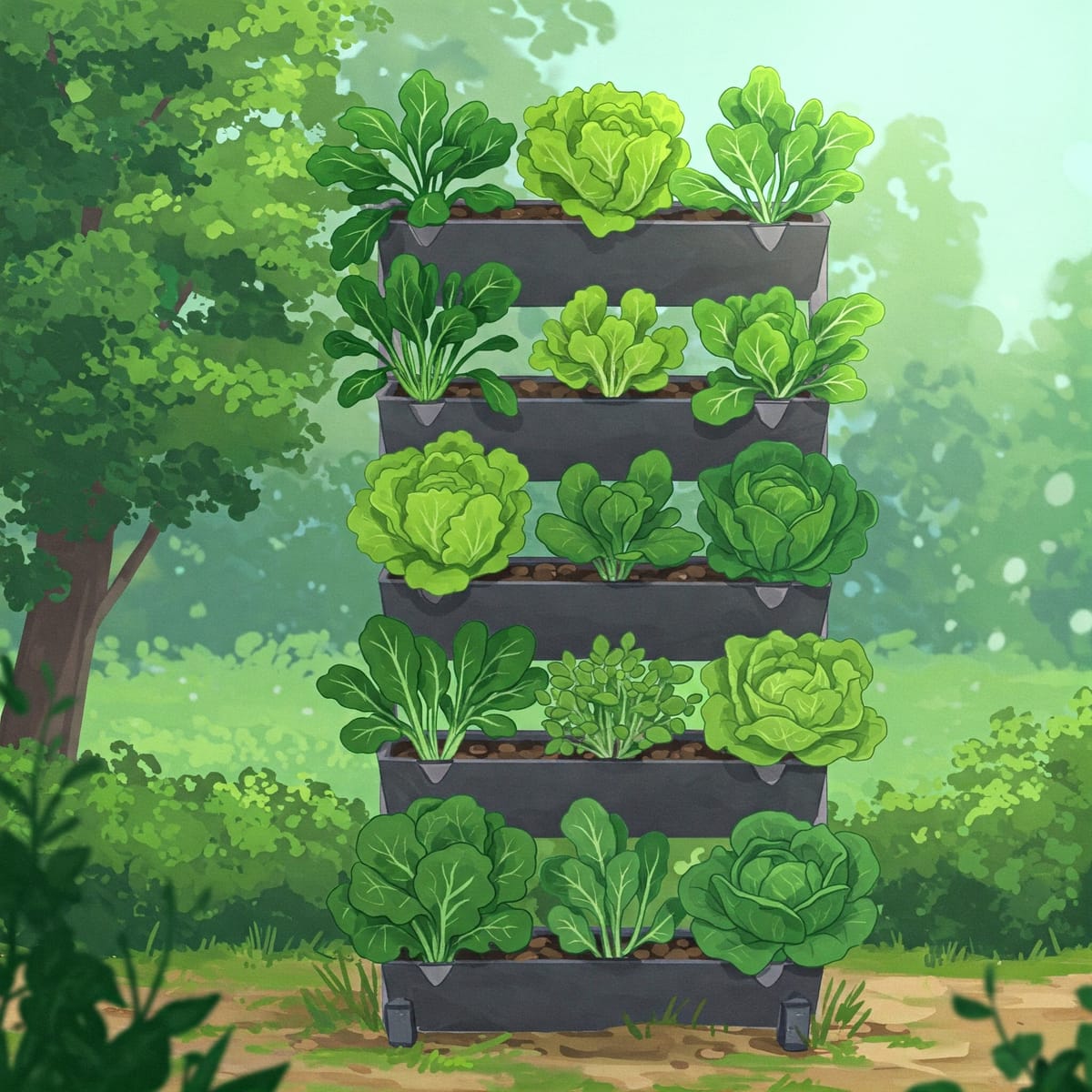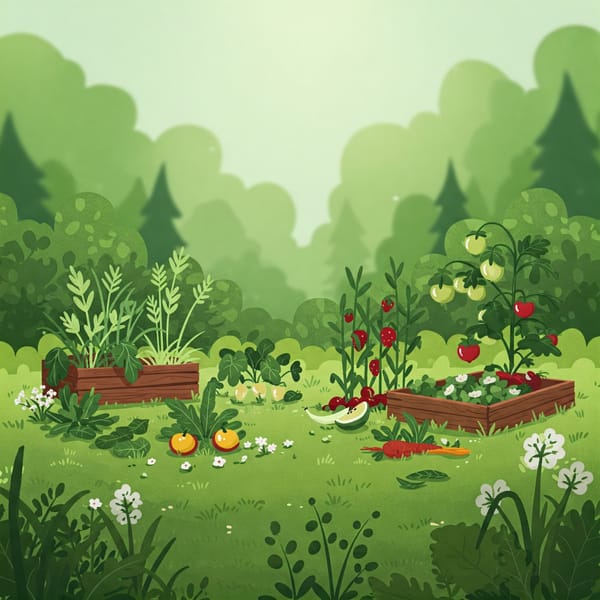Vertical Vegetable Gardens: Maximizing Yield in Small Spaces

TLDR
This report explores vertical vegetable gardening as a solution to the challenges of urban agriculture. It discusses the history of vertical gardening, modern methods, diverse systems for vegetable cultivation, and strategies for maximizing yield in Sydney's climate. The report emphasizes the importance of selecting suitable plant varieties, optimizing environmental conditions, and implementing efficient irrigation and nutrient delivery systems to achieve successful vertical vegetable gardens in limited spaces.
Vertical Vegetable Gardens: Maximizing Yield in Small Spaces
The rise of urbanization globally has led to a decrease in доступность land for traditional gardening, creating a need for innovative solutions to ensure access to fresh produce. Vertical gardening has emerged as a sustainable and efficient method to address this challenge, maximizing the use of vertical space for increased plant density and productivity in urban environments. This report provides a comprehensive analysis of vertical vegetable gardening, focusing on strategies to maximize yield in small spaces, with a specific focus on the context of Sydney, New South Wales.
A Historical Perspective on Vertical Gardening
Vertical gardening is not a modern invention; it has deep historical roots in ancient civilizations. Ancient societies incorporated nature into urban landscapes through vertical gardening for both aesthetic and practical purposes.
- Ancient Examples: The Hanging Gardens of Babylon, dating back to the 6th century BCE, featured terraced platforms with advanced irrigation systems. The Aztecs developed "Chinampas," or floating gardens, demonstrating an adaptation to environmental limitations. Ancient China utilized tiered gardens to integrate natural elements with architecture.
- European Developments: During the Industrial Revolution, vertical gardening was embraced to incorporate nature into increasingly concrete environments. The cultivation of vines in the Mediterranean region dates back to around 3000 BCE, and the technique of espalier became popular in France around 2500 BCE.
Modern Vertical Gardening Methods
The 20th and 21st centuries have seen significant advancements in vertical gardening, driven by technological advancements and a growing focus on urban sustainability and food security.
- Technological Foundations: The development of hydroponics, growing plants without soil in nutrient-rich water solutions, was crucial. The first Tower Hydroponic Units were developed in Armenia in 1951.
- Key Figures and Concepts: French botanist Patrick Blanc developed the first modern green wall in the mid-20th century. Professor Dickson Despommier proposed the modern concept of vertical farming in 1999, envisioning skyscraper farms for urban food production.
- Current Implementations: Today, vertical gardening and farming are implemented globally, from small-scale residential gardens to large commercial operations. Artificial vertical garden solutions emerged in the mid-2010s, offering low-maintenance options for aesthetic purposes.
Exploring Diverse Vertical Gardening Systems for Vegetable Cultivation
Various vertical gardening systems cater to different needs and scales of vegetable cultivation. Understanding their principles, advantages, and disadvantages is crucial for maximizing yield in small spaces.
- Hydroponic Systems: Hydroponics involves growing plants without soil, using nutrient-rich water solutions.
- Advantages: Faster growth rates, higher yields, water conservation, space efficiency, elimination of soil-borne diseases, controlled micro-climates, reduced need for pesticides, and efficient nutrient use.
- Disadvantages: High initial setup costs, power dependency, need for technical expertise, risk of waterborne diseases, limitations for certain vegetables, lack of natural pollinators in indoor systems, high energy consumption for artificial lighting, debate over organic certification, potential for bland taste or reduced nutritional value, labor-intensive maintenance, risk of algae growth, sensitivity to environmental fluctuations, high operating costs, and limited mineral diversity.
- Aeroponic Systems: Aeroponics is a subset of hydroponics where plants' roots are suspended in the air and misted with a nutrient-rich solution.
- Advantages: Faster growth rates, higher yields, greater water efficiency, high efficiency in nutrient absorption and oxygenation, space efficiency, reduced risk of soil-borne diseases and pests, precise environmental control, minimized waste, and year-round crop production.
- Disadvantages: Higher initial setup costs, need for technical expertise, power dependency, vulnerability to power outages, essential and regular maintenance, rapid root drying risk, limited crop variety, risk of equipment failure, need for constant monitoring of pH and nutrient density, impact of water quality, salt and mineral accumulation, lack of beneficial insects and microorganisms, vulnerability to fungal infections and root rot, and high energy consumption.
- Stacked Planters: Stacked planters use tiered containers to maximize growing space in a small footprint.
- Advantages: Space-saving design, mobility, visual appeal, improved airflow, easier maintenance and harvesting, reduced weeding, versatility, maintenance of soil humidity, built-in drainage systems, cost-effectiveness, and flexibility for indoor and outdoor use.
- Disadvantages: Potential for plants to become root-bound, uneven sunlight exposure, quick drying, uneven water drainage, need for rotation, limited soil volume, need for timely harvesting, limited plant suitability, potential for brittleness and degradation, risk of waterlogging and root rot, higher initial cost compared to traditional gardens, limited growing depth, and instability.
- Wall-Mounted Gardens: Wall-mounted gardens involve attaching containers or systems to walls for growing vegetables.
- Advantages: Efficient use of space, aesthetic appeal, easier maintenance and harvesting, reduced risk of soil-borne diseases and pests, increased air circulation, potential for heat retention in cooler climates, creation of privacy screens, versatility, potential for improved air quality and reduced energy consumption, and cost-effectiveness with repurposed materials.
- Disadvantages: Potential for installation damage to walls, need for strong wall support, risk of moisture damage, uneven growth due to shading, faster evaporation, limited plant suitability, need for regular maintenance, potential for nutrient imbalances, challenges with natural light access, risk of overwatering, and potential for bacteria spread in shared watering systems.
Comparative Analysis of Vertical Gardening Systems
| Feature | Hydroponic Systems | Aeroponic Systems | Stacked Planters | Wall-Mounted Gardens |
|---|---|---|---|---|
| Principles | Soilless, nutrient-rich water solution | Soilless, nutrient mist in air | Tiered containers stacked vertically | Containers/pockets attached to vertical surfaces |
| Key Advantages | Fast growth, high yield, water saving, space efficient, no soil issues, year-round production | Fastest growth, highest yield potential, most water efficient, reduced disease | Space saving, easy to move, good airflow, easier harvesting, reduced weeding, versatile | Space saving, aesthetic appeal, easier maintenance, reduced soil diseases, good airflow, versatile |
| Key Disadvantages | High initial cost, power dependency, technical expertise needed, waterborne disease risk, limited crop variety | Highest initial cost, high technical expertise needed, power dependency, rapid root drying risk, limited crop variety | Can dry out quickly, uneven watering/sunlight, limited soil volume, root-bound potential, not suitable for all root vegetables | Installation can damage walls, moisture damage risk, uneven sunlight, faster evaporation, limited plant size/type |
| Best Suited Vegetables | Leafy greens, herbs, strawberries, small fruiting vegetables | Leafy greens, herbs, strawberries, small fruiting vegetables | Herbs, leafy greens, strawberries, shallow-rooted vegetables | Herbs, leafy greens, strawberries, shallow-rooted vegetables, vining plants with support |
| Estimated Cost | High | Very High | Medium | Low to Medium |
| Maintenance Level | Medium to High | High | Medium | Medium |
Tailoring Environmental Conditions for Optimal Vegetable Growth in Sydney's Climate
Managing environmental conditions is essential for achieving high yields in vertical vegetable gardens in Sydney.
- Light Management: Sydney's subtropical climate has ample sunshine, but intensity and duration vary seasonally. Most vegetables need at least 6-8 hours of direct sunlight daily.
- Strategies: Select vegetables suited for full sun, use partial shade for leafy greens in hot months, use supplemental grow lights in limited natural light, utilize reflective surfaces, place sun-loving plants at the top of vertical gardens, position shade-tolerant varieties lower down, and rotate plants for even light exposure.
- Water Requirements: Consistent moisture is crucial, but water needs vary among vegetables.
- Strategies: Use drip irrigation to minimize water loss, employ timed watering systems, ensure proper drainage to prevent waterlogging, and implement water conservation strategies. Hydroponic and aeroponic systems are inherently water-efficient.
- Nutrient Management: Vegetables need a balanced supply of macronutrients and micronutrients.
- Strategies: Use carefully formulated nutrient solutions in hydroponic and aeroponic systems, monitor and adjust nutrient levels and pH regularly, use quality potting mix and organic matter in container-based systems, provide supplemental fertilization, and consider systems like the Garden Tower that integrate composting.
- Support and Structure: Vining plants like tomatoes, cucumbers, beans, peas, melons, and squash need support systems.
- Strategies: Use trellises, stakes, and cages, and ensure the stability and durability of vertical structures, especially in windy conditions.
Strategies for Maximizing Yield in Vertical Vegetable Gardens
Maximizing yield in vertical vegetable gardens requires careful selection of plant varieties and optimization of their arrangement.
- Selecting High-Yield Vegetable Varieties Suitable for Vertical Growth:
- Choose vegetables naturally suited to vertical growth, such as vining tomatoes, cucumbers, pole beans, runner beans, peas, leafy greens, and herbs.
- Consider compact or dwarf varieties for space-constrained systems and shorter or round varieties of root vegetables for specific setups.
- Optimizing Plant Spacing and Arrangement for Enhanced Productivity:
- Provide each plant with enough space for light, air, and nutrients.
- Stagger plant placement, use companion planting, and rotate plants for even sunlight exposure.
- Plan plant placement carefully to prevent overcrowding.
- Implementing Effective Irrigation and Nutrient Delivery in Vertical Setups:
- Use drip irrigation systems for targeted watering and reduced water waste.
- Consider Hydroponic Nutrient Film Technique (NFT) for efficient nutrient delivery and water conservation, especially for leafy greens and herbs.
- Utilize Ebb and Flow systems for good root aeration and versatility for various plant sizes.
- Employ aeroponic nutrient delivery with precision misting for optimal growth and efficient nutrient uptake.
- Addressing Pests and Diseases in Vertical Vegetable Gardens:
- Identify common pests like aphids, spider mites, whiteflies, and caterpillars, and diseases like powdery mildew, root rot, and bacterial infections.
- Implement Integrated Pest Management (IPM) strategies, including preventative measures, biological controls, physical barriers, and organic treatments.
Learning from Success: Case Studies of High-Yielding Urban Vertical Vegetable Gardens
Further research is needed to identify specific case studies of high-yielding urban vertical vegetable gardens in Sydney or similar climates. Analyzing such case studies would provide valuable insights for individuals looking to implement successful vertical vegetable gardens.
Conclusion: Harnessing Vertical Space for Abundant Vegetable Production
Vertical vegetable gardening offers a sustainable and efficient way to produce fresh food in limited urban spaces. Various systems offer different advantages and disadvantages. Maximizing yield requires careful consideration of environmental factors, selection of suitable varieties, optimization of plant spacing, and implementation of effective irrigation and nutrient delivery systems. While challenges exist, the potential for abundant vegetable production in urban areas makes vertical gardening a valuable tool for promoting urban sustainability and food security.




